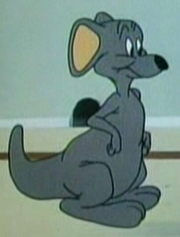| Hippety Hopper | |
|---|---|
 A still of a scene of Hippety Hopper as he appeared in his self-titled film (animated by Manny Gould). A still of a scene of Hippety Hopper as he appeared in his self-titled film (animated by Manny Gould). | |
| First appearance | Hop, Look and Listen (1948) |
| Created by | Robert McKimson |
| Voiced by | Mel Blanc (1950–1961) Gilbert Mack (1956) Debi Derryberry (Bugs Bunny Builders Episodes 1-26) Sky Alexis (Bugs Bunny Builders Episodes 30-present) |
| In-universe information | |
| Species | Kangaroo |
| Gender | Male |
Hippety Hopper is a young kangaroo character in the Warner Bros. Looney Tunes series of cartoons. Robert McKimson introduced Hippety Hopper in Hop, Look and Listen (1948), which established the pattern for future Hippety Hopper cartoons. The character appeared in 14 theatrical cartoons between 1948 and 1964.
History
Hippety Hopper cartoons have a typical formula: Hopper escapes from a zoo, circus, etc., and is mistaken for a giant mouse by Sylvester the Cat. Frequently, Hopper changes places with an actual mouse, generally when it is most embarrassing for Sylvester. Sylvester tries to capture and eat his "prey", but the innocent and infantile Hippety mistakes Sylvester's predations for a game of rough-housing. Sylvester is repeatedly kicked, punched and spun around, but each failure only strengthens his desire to have the "giant mouse" for lunch.
Hippety Hopper returns in McKimson's Pop 'Im Pop! (1950), in which proud father Sylvester boasts of his mousing skills to his son, Sylvester Jr. In Cats A-Weigh! (1953), Sylvester accepts a position as mouse-catcher on a ship. He encounters Hippety Hopper being shipped from Australia. Sylvester mistakes Hippety Hopper once again for a giant mouse and the baby kangaroo promptly beats the cat soundly. Junior is mortified, but the true victim is Sylvester, humiliated by a mere "mouse" in front of his own son.
McKimson would continue the Sylvester/Hippety Hopper series for 16 years, varying it slightly from cartoon to cartoon. In Bell Hoppy (1954), for example, in a twist on "belling the cat", Sylvester must hang a bell around the neck of the biggest mouse that he can find in order to join the "Loyal Order of Alley Cats Mouse and Chowder Club". Surprisingly, he actually succeeds this one time and gets to join the club, even becoming its Grand High Exalted Poobah, "being the only active member" (the other members were hit by the city zoo truck taking Hippety away to the zoo when they tried to catch him after Sylvester belled him).
In Lighthouse Mouse, Sylvester must guard a lighthouse from the baby kangaroo and a mouse who wants nothing more than to turn the lighthouse's light off just so that he can get some sleep.
Hoppy Go Lucky (1952) was a parody of Of Mice and Men, with Sylvester accompanied by the giant, simple-minded cat "Bennie", who wants a mouse "to hug him and pet him". The central theme is always the same: Sylvester is shamed for his failure to capture what seems to be a simple "mouse".
Hippety Hopper also appeared on records produced by Capitol Records and Golden Records. Unlike in the cartoons, Hippety actually spoke frequently on these, voiced by Mel Blanc using an Australian accent.
The Hippety Hopper/Sylvester/Sylvester Jr. cartoons ended in 1964 when the Warner Bros. studio closed its animation unit.
Originally Hippety Hopper intended to appear as a cameo in the film Who Framed Roger Rabbit (1988) in the deleted scene "Acme's Funeral".
Appearances
All of the shorts from 1948 to 1964 were directed by Robert McKimson.
- Hop, Look and Listen (1948)
- Hippety Hopper (1949)
- Pop 'im Pop! (1950)
- Bushy Hare (1950, cameo)
- Who's Kitten Who (1952)
- Hoppy Go Lucky (1952)
- Cats A-Weigh! (1953)
- Bell Hoppy (1954)
- Lighthouse Mouse (1955)
- Too Hop to Handle (1956)
- The Slap-Hoppy Mouse (1956)
- Mouse-Taken Identity (1957)
- Hoppy Daze (1961)
- Freudy Cat (1964)
References
- "News From ME - Mark Evanier's blog". www.newsfromme.com. Retrieved 3 December 2020.
- Markstein, Don. "Hippety Hopper". Don Markstein's Toonopedia. Retrieved 2 April 2020.
- Lenburg, Jeff (1999). The Encyclopedia of Animated Cartoons. Checkmark Books. p. 92. ISBN 0-8160-3831-7. Retrieved 6 June 2020.
- Rovin, Jeff (1991). The Illustrated Encyclopedia of Cartoon Animals. Prentice Hall Press. p. 121. ISBN 0-13-275561-0. Retrieved 8 April 2020.
- Beck, Jerry; Friedwald, Will (1989). Looney Tunes and Merrie Melodies: A Complete Illustrated Guide to the Warner Bros. Cartoons. Henry Holt and Co. p. 262. ISBN 0-8050-0894-2.
- Beck, Jerry; Friedwald, Will (1989). Looney Tunes and Merrie Melodies: A Complete Illustrated Guide to the Warner Bros. Cartoons. Henry Holt and Co. p. 255. ISBN 0-8050-0894-2.
- "Bugs Bunny and His Friends on Capitol Records". Retrieved 2017-12-29.
- "Golden Records' "Bugs Bunny Songfest"". Retrieved 2017-12-29.
- Hill, Jim (8 May 2014). "Storyboards reveal what Marvin Acme's funeral in "Who Framed Roger Rabbit" would have looked like". jimhillmedia.com. Retrieved 24 July 2020.
External links
- Hippity Hopper at Don Markstein's Toonopedia. Archived from the original on February 5, 2016.
| Hippety Hopper in animation | |
|---|---|
| Short films |
|
| Feature films |
|
| TV series |
|